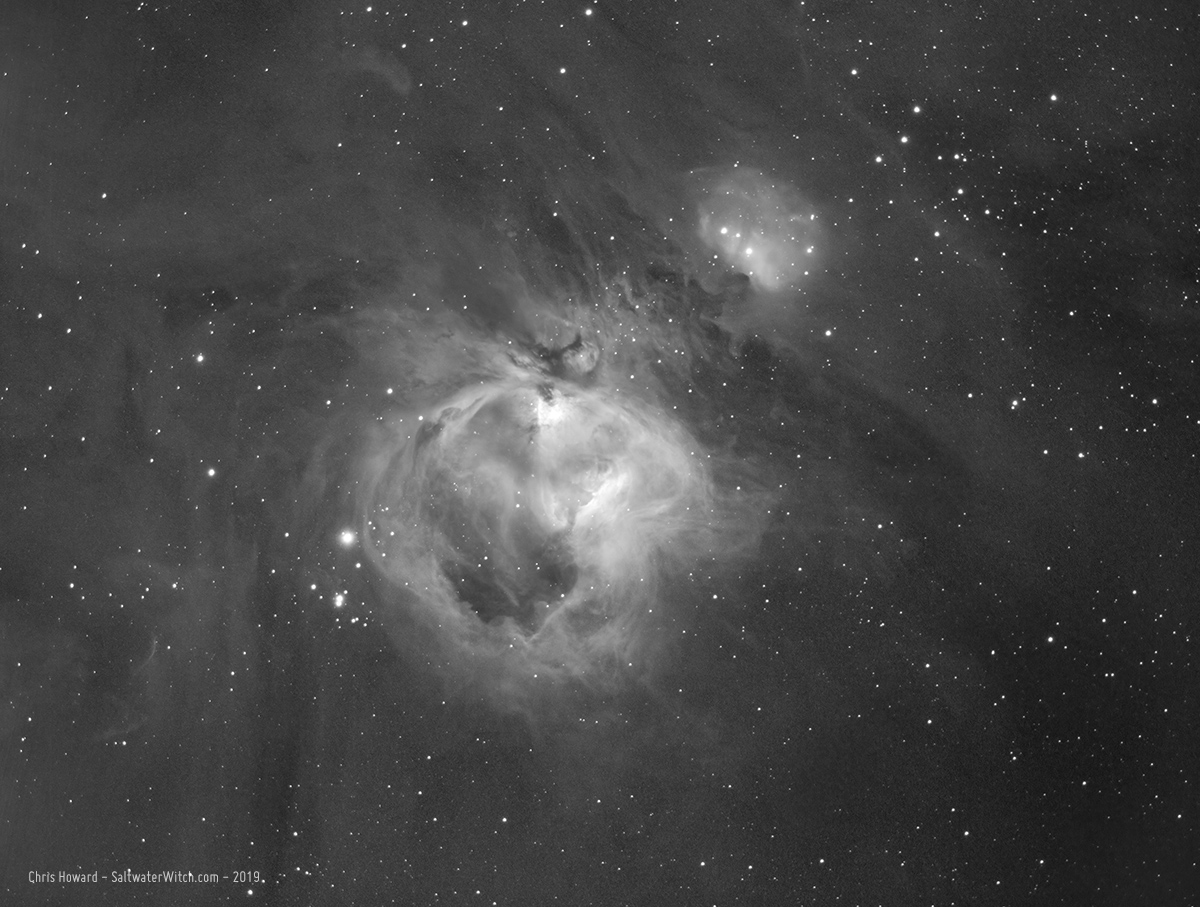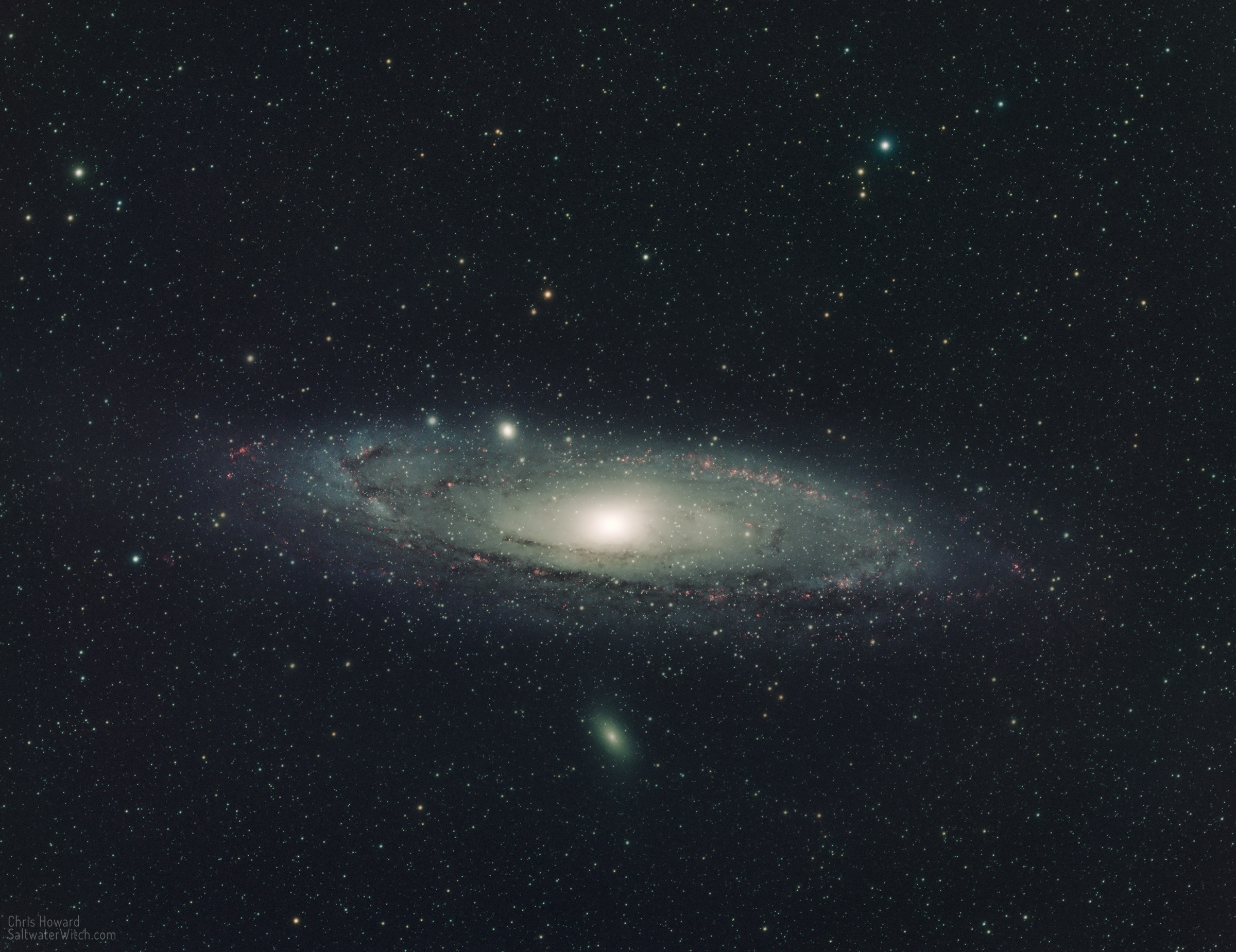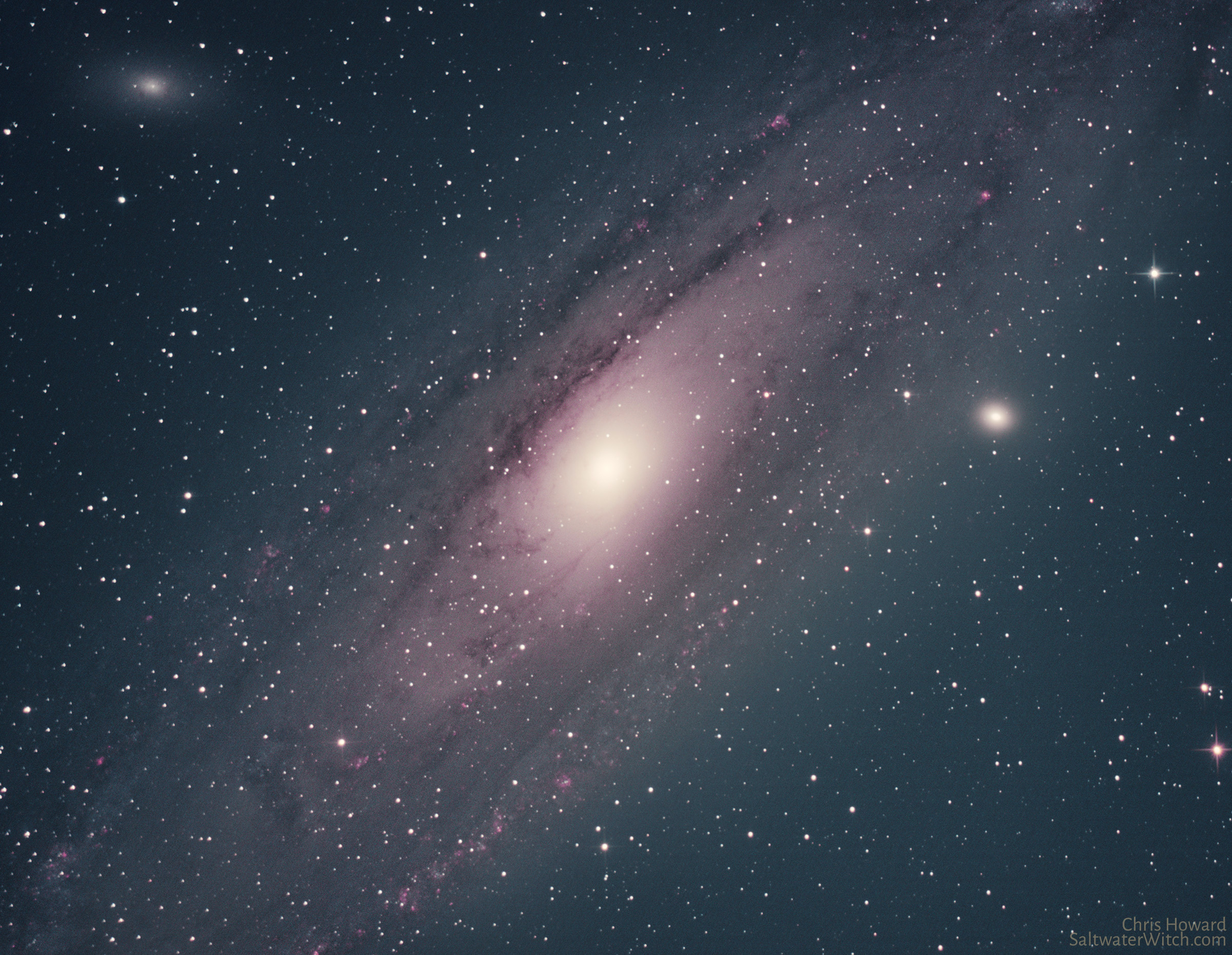M31 in HaRGB
Beautiful skies last night, mostly clear, and no moon, the perfect night for broadband color with separate RGB filters, and I went after one of the finest northern hemisphere color targets. Andromeda (M31) is one of our galactic neighbors at only 2.5 million lightyears away. Our own galaxy, the Milky Way, may have as many as 400 billion suns, while Andromeda may have as many as a trillion suns. M31 is about 152,000 light-years across, and the Milky way is a bit under 90,000 lightyears. We're both good-sized barred spiral galaxies. Stick around for a few billion years and you can watch us collide and form one massive galaxy. Notes: 51 x 120-sec Red, 53 x 120-sec Green, and 56 x 120-second Blue filter (Astronomik Deep Sky RGB filters), 60 x 180-second Hydrogen-alpha (Astronomik 6nm), ZWO ASI1600MM-Pro monochrome camera running at -10C, ZWO AM5 EQ mount, William Optics SpaceCat 51 apochromatic refractor.
The Milky Way and Andromeda are two of the largest members of the Local Group, which contains about 80 galaxies, most of which are dwarf galaxies with something like 10 billion stars or fewer. M110 (below) and M32 (above) are satellite galaxies of Andromeda, and both are dwarf galaxies in the Local Group. Most of these dwarf galaxies don't have much of an internal structure, no dust lanes, very little star formation. (M110 is an exception, in that there are remnants of a spiral of interstellar dust and there's ongoing research looking at M110's origins and development). Andromeda may contain a trillion solar masses and the Milky Way galaxy contains around 400 billion solar masses—give or take a few billion. From our perspective along the Orion-Cygnus Arm (sometimes called the "Local Arm") of the Milky Way, the Andromeda Galaxy is at an angle, tipping toward us, inclined around 77° relative to Earth. I believe the edge of M31 with M110 (bottom in this rotation) is the side closest to us. One of the notable catalogued regions within the galaxy is NGC 206 (bright bar on the lower left side), a star forming region with hundreds of relatively new spectral class O and B stars. These hot blue-giant stars are so bright and massive we can resolve them from our galaxy with consumer telescopes.
Posted September 25, 2022
M31 and M33
I used the Optolong L-eXtreme for half of the exposures, filtering out everything except 7nm lines along hydrogen-alpha and oxygen 3, and then switched to full broadband, just the UV/IR Cut Filter. Notes: 8" 800mm f/4 Newtonian and the ZWO ASI071MC cooled color camera.
I'm not really a galaxy guy, more of a nebula guy, mainly because I don't have a scope over 1350mm, which is just long enough to get a handful of nearby galaxies. So, for now, I usually capture a couple of our galactic neighbors when they swing around this time of year--and if the moon and clear night skies line up for broadband color imaging!
The central region of M31, Andromeda Galaxy:
The Triangulum Galaxy from my backyard--it's only 2.73 million light-years from Earth! I've said it before. Once we develop MFTL technology (Much Faster Than Light) and we have the ability to hop to nearby galaxies, count me in on a trip to M33, the Triangulum Galaxy. The chunky pinkish masses are vast regions of interstellar ionized hydrogen that make up the nebulae in M33, perfect for an astrophotography outing. Until then, maybe we can take a trip to the southern hemisphere? Notes: Apertura 8" Newtonian OTA--800mm at f/4, ZWO ASI071MC cooled color camera. Optolong L-eXtreme dual narrowband filter. 48 x 240-second exposures stacked in DSS.
Posted September 4, 2022
M31, Andromeda Galaxy
Another one from last night's imaging run--finished up last night, with 34 subs from November 1st: Our largest galactic neighbor, Andromeda, with the William Optics SpaceCat 51 refractor and the ZWO ASI071MC cooled color camera.
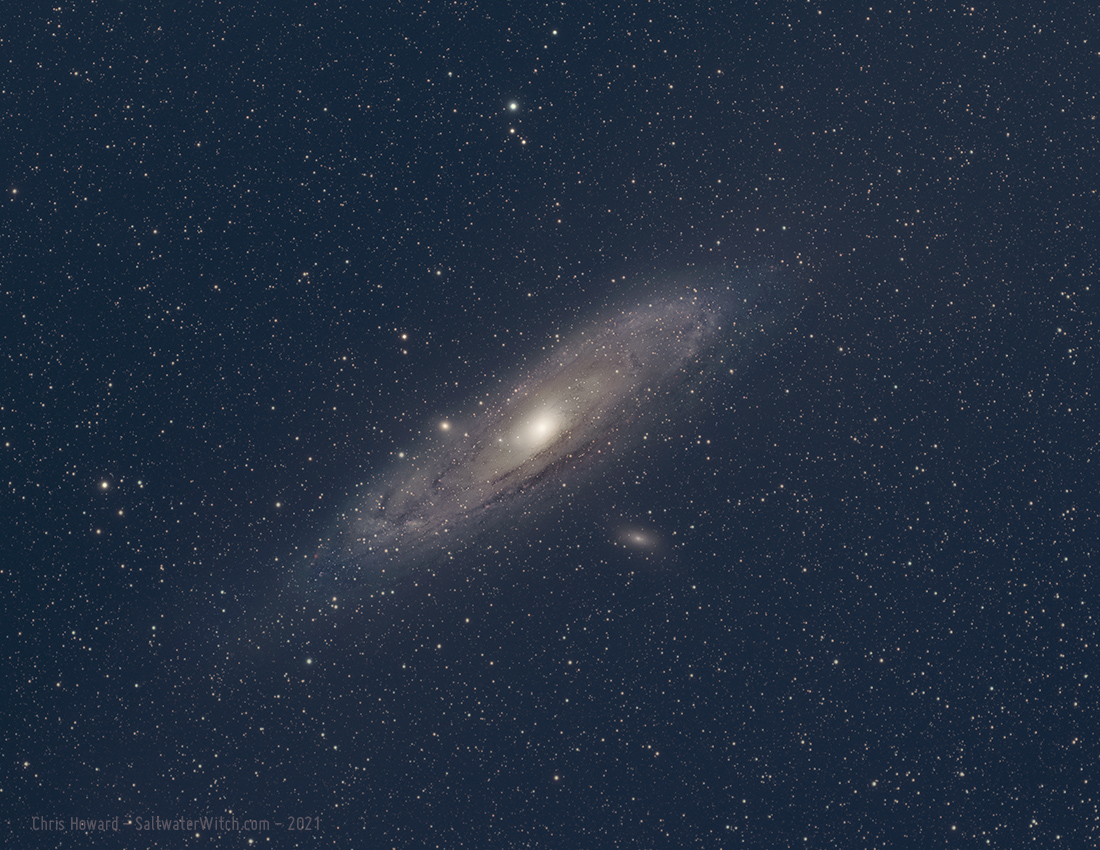
Posted November 4, 2021
M31 in BLUE
This is the blue bandpass of the Andromeda Galaxy (M31), revealing dense spirals of dust that wind through starfields and curl around the galactic core. I have labeled NGC 206, one of the brightest of the star clouds inside Andromeda, along with a couple of M31's captive galaxies (M32 and M101). Imaging Notes: 51 x 120-second stacked subs from my WilliamOptics SpaceCat51 (250mm FL) and ZWO ASi1600MM-Pro mono camera.
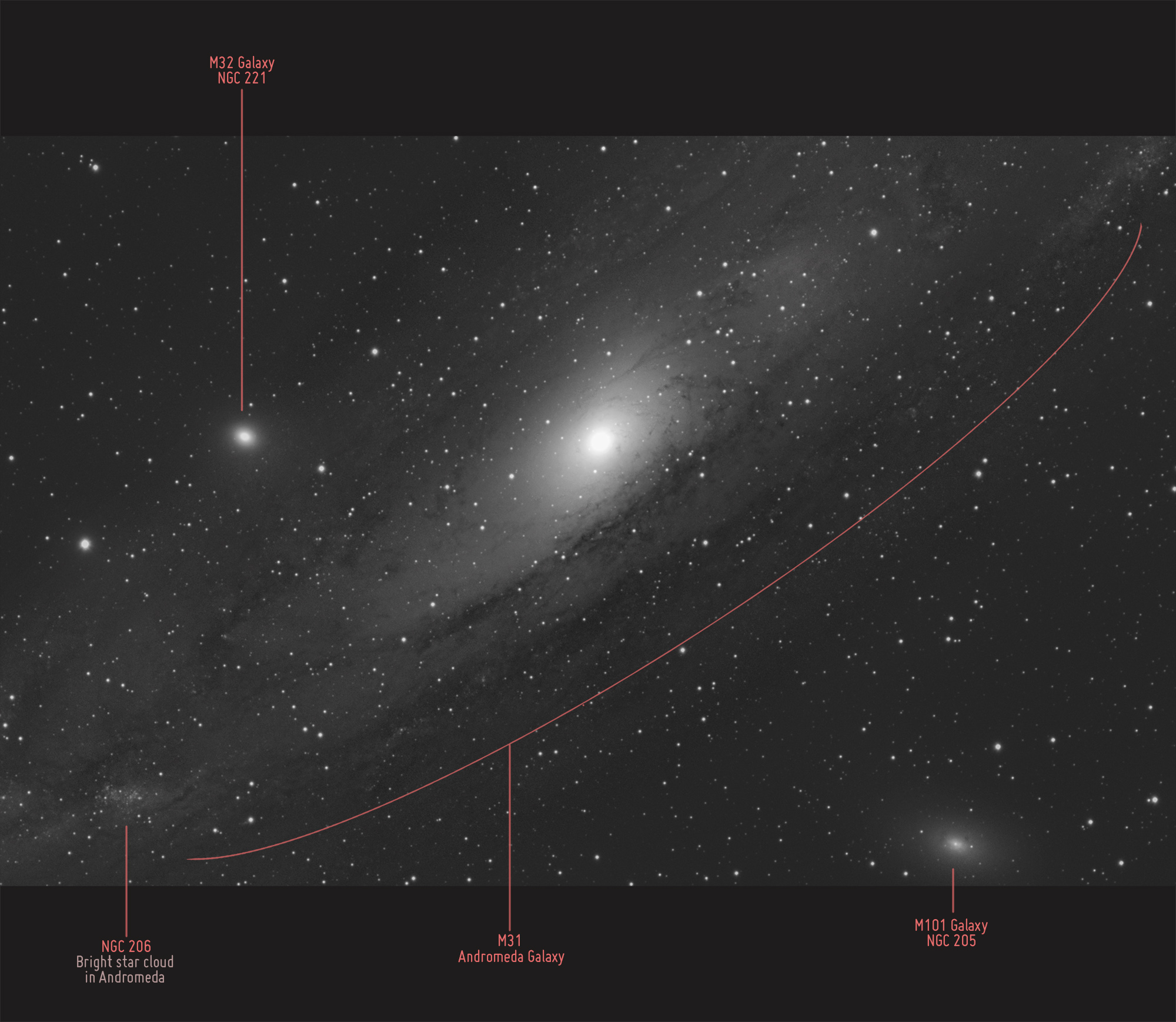
Posted October 29, 2021
Andromeda never gets old
Here it is in hydrogen-alpha, just the one narrowband slice of the spectrum. Andromeda Galaxy, Messier 31, is probably the first target for northern hemisphere astrophotographers--well, it's either M31 or M42 Orion Nebula. Both are intensely bright deep sky objects you can see without a telescope, given reasonably clear and dark skies. I have captured M31 more times than I can count. The galaxy stands out in the night sky when it swings around every year, making it an easy target. Galaxies are also great full spectrum targets for color cameras, DSLRs and mirrorless cameras, but that doesn't mean you can't pull some awesome data out of Andromeda in narrowband or infrared. I captured M31 in near-infrared (longpass 850nm) a couple years ago, and last night I captured our galactic neighbor in very narrow hydrogen-alpha (3nm Ha), and this stacked set of 42 sub-exposures highlights massive HII regions, mostly emission nebulae, along the outer spiral arms, with dense bands of dust and debris ringing the galactic core. This will make a great red channel in an RGB image, or I may go with HaRGB.
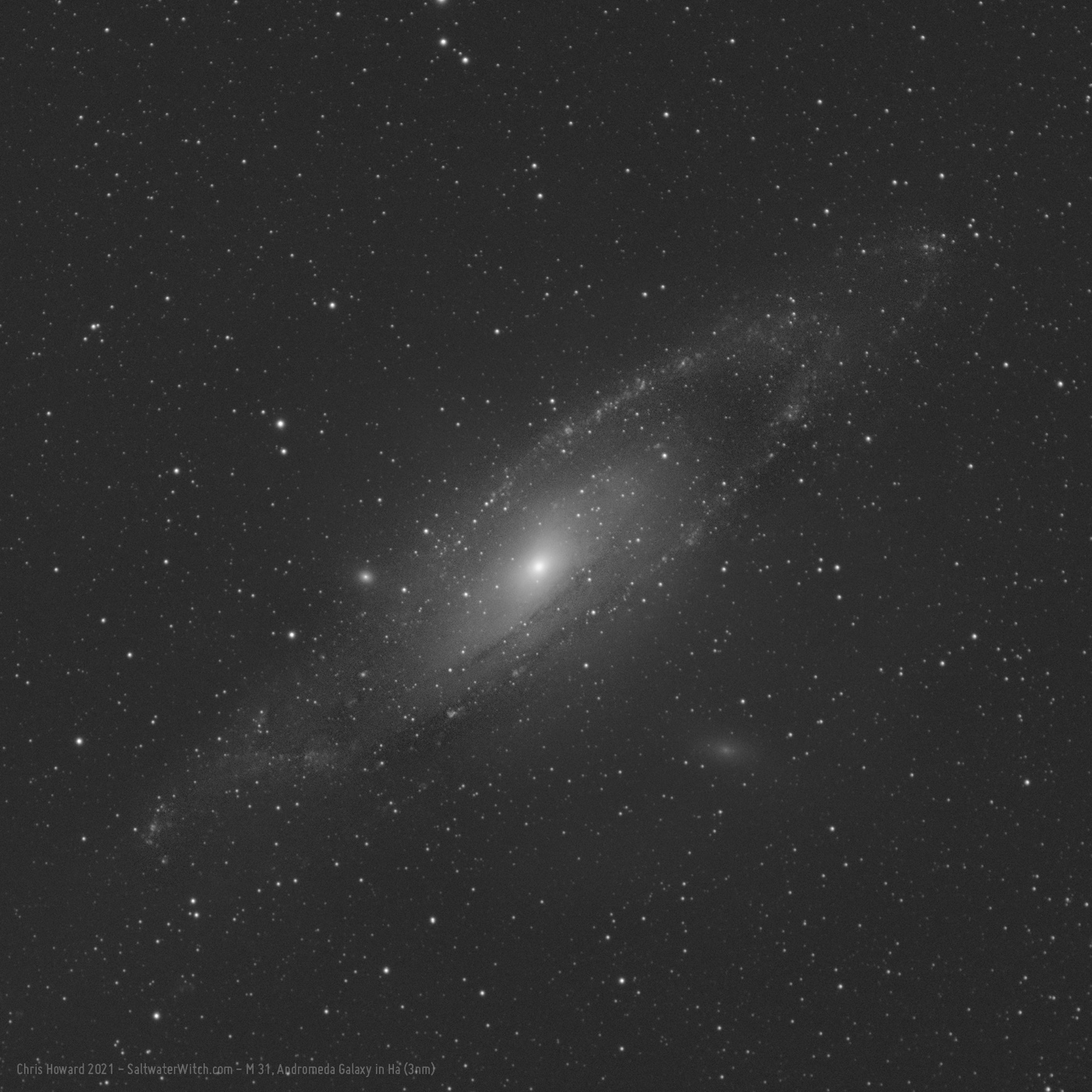
Posted October 8, 2021
Andromeda from the Galactic Edge
Here's the Andromeda Galaxy (M31) without the stars and other clutter from our own galaxy in the way. I have processing tools that will algorithmically remove stars from an image, and it does a reasonable job. What I'm showing here is what Andromeda would look like if you could travel from our location on the Orion Spur (a minor branch off one of the Milky Way's spiral arms), pass through the Perseus Arm, to the edge of our galaxy, and then take some pics of M31. Our star, the Sun, sits in the middle of one side of our galaxy. We are so used to seeing a star field in astro images we do not realize all the stars we can see in the night sky--with our eyes, are in our own galaxy. Some of those pinpoints of light are galaxies themselves but are so far away they appear no different from stars to our eyes. In this image of M31 the two star-like objects above and below Andromeda are M110 (larger, below) and M32 (above). These two are actually satellite galaxies that orbit Andromeda. Yes, just as stars have planets, and planets have moons, large galaxies can capture other galaxies in their gravitational pull. Our galaxy, the Milky Way, has several in orbit, including the Large and Small Magellanic Clouds.
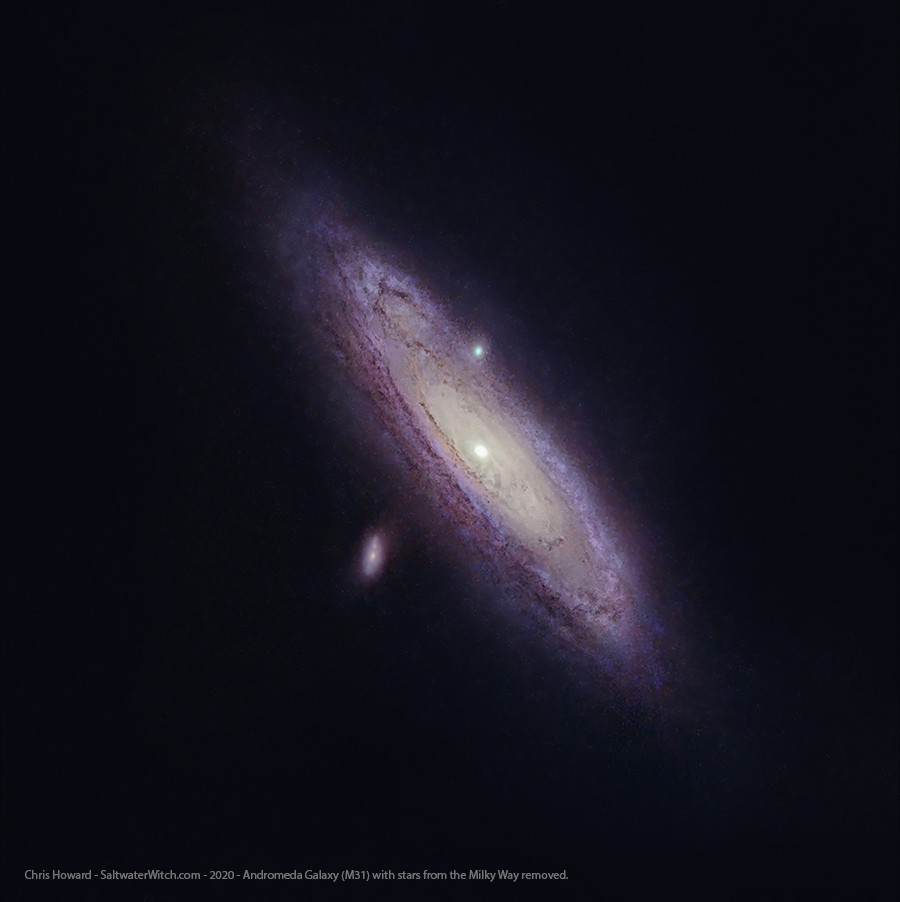
Posted April 28, 2020
Updated William Optics SpaceCat 51 setup with Autofocus
If you have seen some of my videos and blog posts on the Cat you know I have two astro camera trains, one color, one narrowband. This one consists of a ZWO ASI1600MM-Pro mono, ZWO ASI filter wheel with Astronomik 6nm HA, OIII, and SII filters, along with a CLEAR in slot one, and a near-IR filter in the fifth position.

Another reason I want to show off this setup is the single-power wire config. Everything else is on the scope or controlled wirelessly--for example, the iOptron CEM25P or my Orion Atlas can be controlled by Ekos through wifi or bluetooth.

I shot some beautiful color images earlier this year and late last. I'll show M31 and a couple others later, but with that color setup I was running multiple power cables and a heavy duty USB cable to the scope, and although this is setup, which I will try out as soon as it clears up, looks a bit cluttered, I want fewer cables running from cameras, controllers, focusers, and other devices. Fewer cables reduces the chance of one of them hanging up on the mount, or swinging just enough with a gust of wind to throw guiding off.
The controller--the aluminum box on the left side is a Raspberry Pi 4 with 4 gigs, running INDI, Ekos, KStars. I remote into this just like I would with with Windows to run Sequence Generator Pro. The only difference is this box is mounted to the scope. I am looking at running my Windows-based astro controller and sequencer stuff on a similarly small single board computer, and then I can just swap out one system for another. 4 USB ports on the Pi, though, really does make things easier.

I am using the DeepSkyDad AF3 belt-drive autofocus, with the helical focuser timing belt ring made for the cat. I think Pavle at DeepSkyDad sells the components by themselves if you're interested in doing something like this. The rest of it is made up of various SmallRig camera rails, clamps, and support pieces.

I also have GPS via a USB dongle to automatically get accurate date, time, longitude, latitude, and altitude for Ekos and KStars.
Of course, as is typical, I'm ready to go and the weather's supposed to cloud over in the next couple hours, right around sundown. Hmmm. It's almost as if there's a conspiracy.
I don't normally need dew control this time of year and maybe halfway through the summer, but I will add a dew heater when I need to, but still keeping with a single 10 - 15 amp 12 volt dc line in, and I'll see if that's enough to drive all the devices. Planning this stuff out is half the fun.
That white rectangular shape under the Raspberry Pi is a DC step down converter, taking 12v dc to 5v at 5 amps. The Raspberry Pi 4s need a bit more current then the older 3s.

Before I pack it up, I want to show off a couple astro images from a couple different imaging runs.
The first is the Rosette Nebula NGC 2237 in Monoceros, a large circular HII region. The open star cluster NGC 2244 has formed out of—and continue to form out of—the Rosette's abundance of hydrogen and other materials. NGC 2237 is about 5000 lightyears away from us, and it's about 130 lightyears across. That's Sh2-280 on the right, a dim diffuse nebula. Another one from my backyard with the William Optics SpaceCat 51 250mm FL APO refractor, iOptron CEM25P EQ mount, ZWO Astronomy Cameras ASI071MC cooled color camera, Celestron UHC/LPR filter. 13 x 2-minute exposures, 4 x 8 minute exposures.
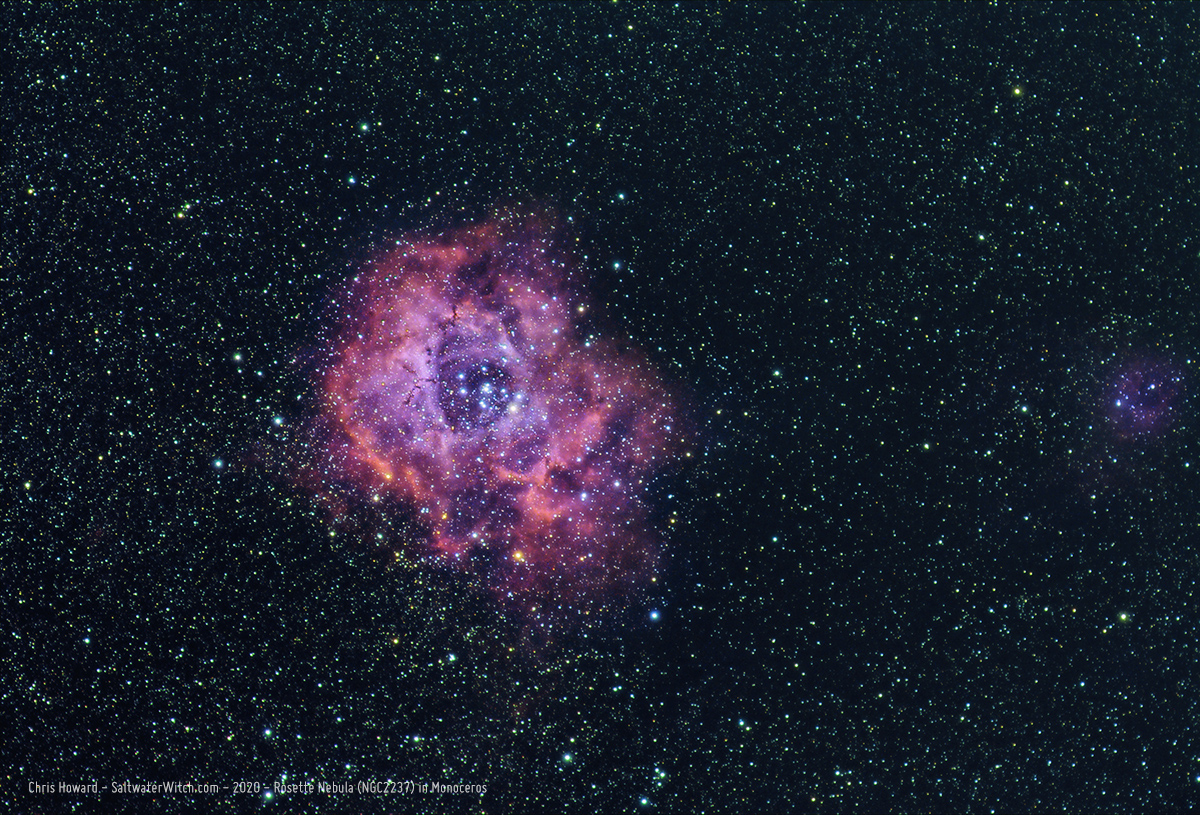
One more from my backyard with the WilliamOptics SpaceCat 51 refractor and the ZWO ASI071MC camera: the grandest of the galaxies, Andromeda, M31. Of course, there are millions of incredibly beautiful and strange—and even downright bizarrely structured galaxies out there in the universe, many within normal telescope distance, but in my opinion they don't come close to M31. You could argue the Pinwheel Galaxy (M101) is in the running because it is so perfectly positioned from our perspective, a wonderful top-down view of a spiral galaxy. But Andromeda is like the Platonic ideal of a spiral galaxy. M31 also happens to be our largest galactic neighbor. So at 2.5 million lightyears away, it's close by. It's also much larger than M101, with a trillion stars and a hundred thousand lightyear diameter. This is probably one of the first objects an astronomer or astro-imager in the northern hemisphere is going to view or capture. You can see it without a telescope on a clear dark night. Andromeda Galaxy was first documented by astronomer 'Abd al-Rahman al-Sufi in 964. He described it as a "nebulous smear" in his famous Book of Fixed Stars, which is exactly what it looks like without a telescope—and if you know where to look. It's in the constellation Andromeda, so that should get you pointed in the right direction if you're inclined. Note: This image is a combination of RGB color and near-infrared frames I captured earlier this year and late last year. I'm just getting around to processing them!
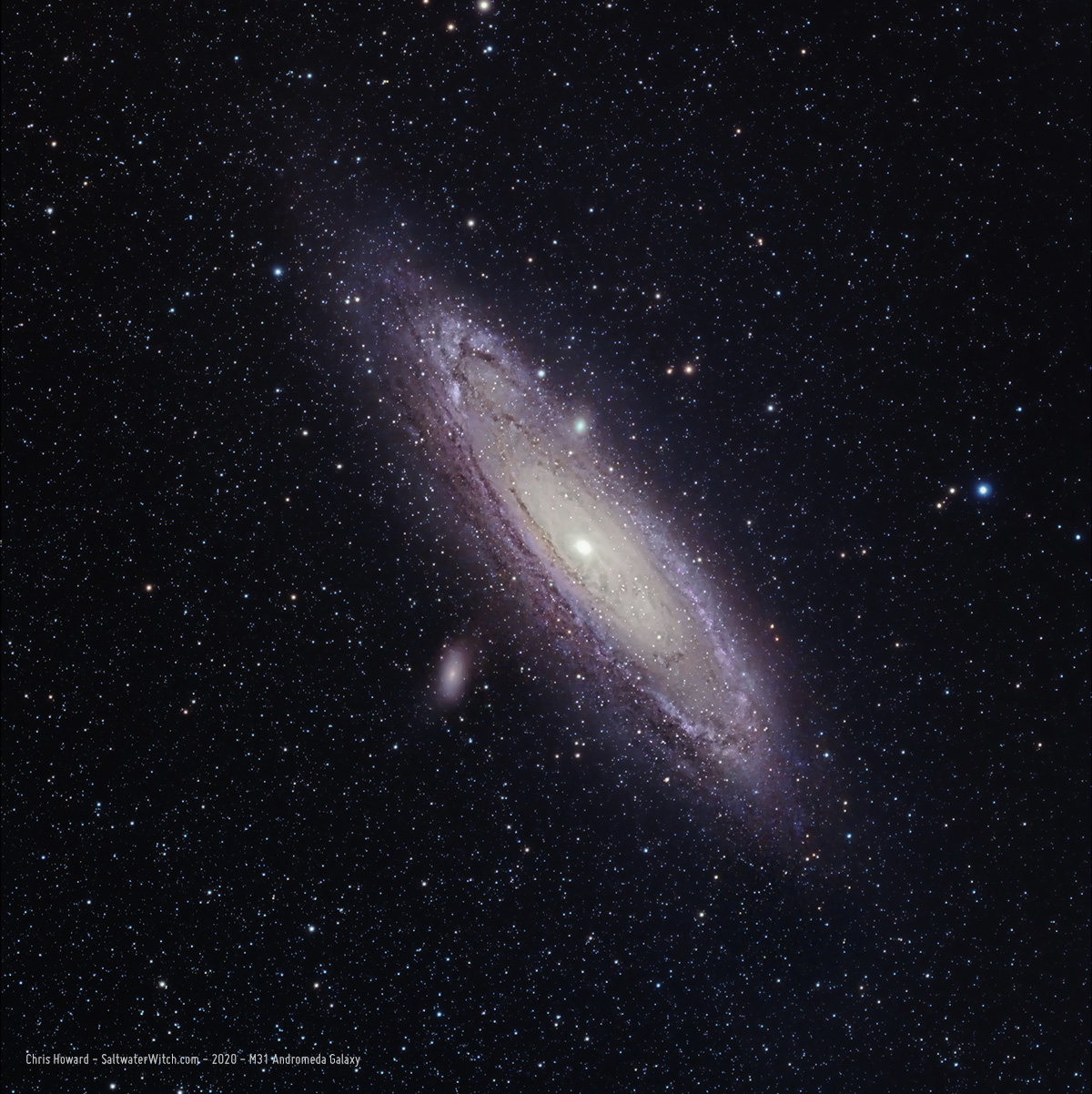
Okay, so that's it for now. Just a quick walkthrough of my narrowband rig with the William Optics Space 51 and autofocus. And with a single cable running to the setup. So, this setup really is plug in the power, polar align, and start taking subs.
Well, we'll see how easy it is once we get some clear night sky!
Posted April 26, 2020
High-gain Test - Gathering Narrowband Data
Autumn is officially here, and this is the season of the Pleiades, Orion, the nebulae in the constellations of Perseus, Monoceros, Auriga, Taurus, and Gemini. Now, M42 isn't in view until 2am, so that had to be the last in the sequence. And, yes, you can tell I was just dorking around with filters with our galactic neighbor, Andromeda M31, in near IR and hydrogen-alpha. I know M31 is a decent Ha target, and you can see some wonderful images in Ha-RGB out there in the world, but I had never tried shooting 2-minute subs of M31 with a 685nm long pass filter.
I ran the ZWO ASI1600MM-Pro mono CMOS camera at a gain of 200 and offset of 65 in the following shots. And no calibration frames for any of these. Higher gain reduces dynamic range, but you're also reducing read noise and gaining (ha ha) resolution and the ability to shoot shorter exposures--and more of them, and if you take enough subs, this should balance things out. There are miles of discussion on gain and offset in astro-imaging, but I was recently reading Jon Rista's comments in an astrobin forum thread and that got me to test out higher gain/offset.
M31 in Near-IR + Ha

I moved over to Cassiopeia and shot 40 x 4-minute subs each of IC 1805 (Heart Nebula) and IC 1848 (Soul Nebula) in Hydrogen-alpha. Here's the stitched together pair:
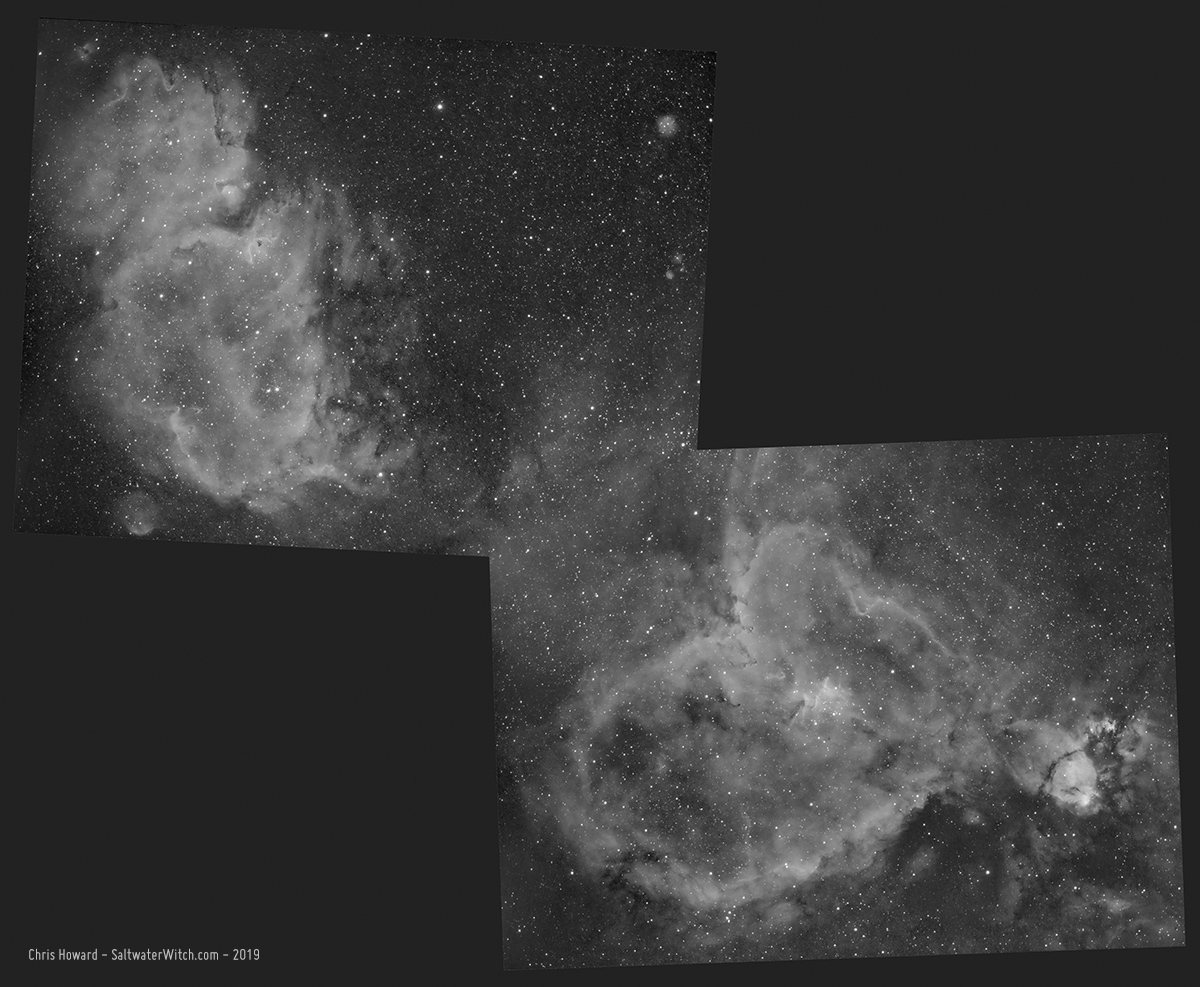
Still waiting for Orion to get above 30°, I spent some time on NGC 1499 "California Nebula"

And Orion is back in the sky! Sure, you have to get up at 3 in the freakin' morning to see it with your own eyes. Or you can program your astro imaging system to stay up all night and take pictures without you. Here's M42, Orion Nebula, along with M43, De Mairan's Nebula--that's the spherical-looking cloud formation with the big bite taken out of it. And above that, shining brightly, Sh2-279 Running Man Nebula--although the famous running man shape isn't clear in hydrogen alpha. I'm not sure how well it comes out with oxygen III and sulfur II, but I'll come back another night to capture the OIII and SII frames. Notes: 31 x 240 second exposures in Ha + 20x 10 second subs just for the Trapezium (the super bright core of the Orion Nebula--so bright I have to take separate short exposure shots and merge it back in processing). William Optics GT81 APO refractor, ZWO ASI1600MM-Pro mono camera, Astronomik 6nm Ha filter.
